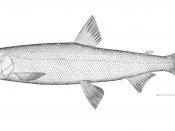Kayla Marques
ENC1102
Mr. Garcia
The Aquatic Past of Humans
The evolution of humans is constantly in question. The most common evolution theory that scientists and most people believe is the "savannah" model. It declares we derived from primates because of the shared similarities such as flexible fingers and toes, opposable thumbs, and more. These features are supposed to be adaptations from the savannah region mammals, but most of the animals living in this area are covered in hair and walk on four legs. None of these adaptations are seen in humans. The Aquatic Ape Theory of evolution states that humans evolved from the sea and had an aquatic era. Basically, it is the idea that our ancestors were trapped in a semi-aquatic environment and over time, altering their bodies to be more effective in the water. Physiologically speaking, our features are rare in comparison to land mammals yet closely resemble those of aquatic mammals.
The evidence gathered proves that our earliest ancestors were living in this semi-aquatic habitat for quite some time. Nothing in the fossil record is inconsistent with this theory and the geological proof also supports this hypothesis.
Some might think it would've been impossible for humans to make the change from terrestrial to marine but we aren't the only mammals who have done so. All cetaceans, which includes porpoises, dolphins, and whales are descendants of land-living mammals. That means that their terrestrial ancestors morphed over millions of years into the whales and dolphins we know today. DNA studies and the anatomy of other living animals have concluded that whales are part of a mammalian group called the Artiodactyla. Modern animals that are also part of that group include giraffes, camels, cows, and pigs. Whales and dauphins have forelimbs that have modified into flippers.


